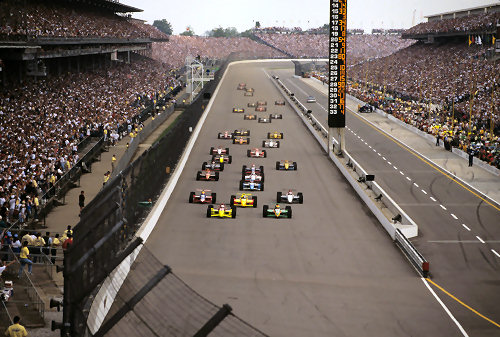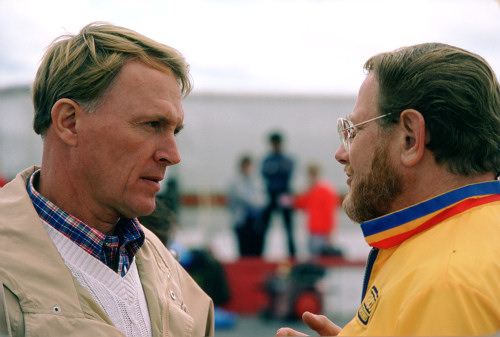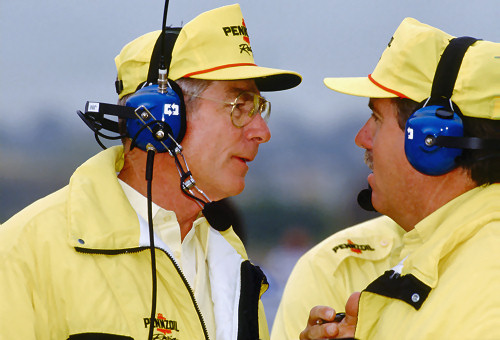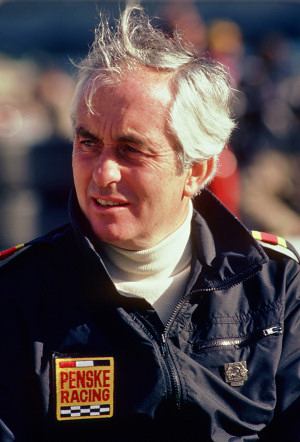The Way It Is/ Ignoring Dan Gurney's words of wisdomby Gordon Kirby |
 When automobile racing began to take shape in America during the early years of the twentieth century, most major races were organized by the American Automobile Association (AAA). The AAA quickly established itself as America's largest automobile club and ran the country's National Driving Championship from as early as 1909 through 1955.
When automobile racing began to take shape in America during the early years of the twentieth century, most major races were organized by the American Automobile Association (AAA). The AAA quickly established itself as America's largest automobile club and ran the country's National Driving Championship from as early as 1909 through 1955.
That was the year 1953 & '54 Indy 500 winner Bill Vukovich, seemingly on his way to becoming the race's first three-in-a-row winner, was killed in a multi-car accident while leading the 500. Thirteen days later 82 spectators were killed at Le Mans when Pierre Levegh's Mercedes' crashed into the crowd. Those disasters convinced the AAA's board of directors that racing was too dangerous for their flourishing primary business of insuring America's motorists. The AAA pulled out of the sport to focus entirely on their core business, leaving Indianapolis Motor Speedway president Tony Hulman to create a new organization out of the AAA's contest board. The new group was called the United States Auto Club (USAC), and was based just down the road from the Speedway, on Sixteenth Street in the Indianapolis suburb of Speedway, Indiana. The Hulman family were successful bankers from Terre Haute, Indiana, eighty miles west of Indianapolis, and Tony Hulman, son of the family's founding father, bought the Indianapolis Motor Speedway in 1945, after the end of World War II. Hulman rebuilt the dilapidated old track and soon became the most important man in the sport. When the AAA pulled out of racing, Hulman was the natural man to take over and he used his power and personality to create USAC which ran Championship or Indy car racing from 1955-'79.  © Racemaker/Paul Webb Indy 500 aside, most USAC races paid very little prize money, didn't draw very big crowds and weren't televised. The series was all about Indianapolis with a string of second-rate races running at only seven tracks. "Indy was the hub around which the USAC championship revolved," observes racing legend Dan Gurney. "The tradition at Indy was to have one race a year and it was a big one that paid a great purse and had tremendous history. It was just a great event. At the time it was far and away the biggest in the world of racing. Maybe Le Mans came close, but Indy was the big one. "USAC was a child of the Speedway. USAC was there to run the month of May and it also was allowed to have its own additional other races that made up the national championship series. That was fine, not a problem, but the rest of the championship series was bogged down. It didn't have any leadership and was more or less derelict. "There was not much linkage between all the other races and the Indy 500. The rest of the races were sort of orphans that nobody paid attention to. Nor had anybody heard the word marketing. The waters were stagnant. "You can't run the business of a racing team with just one big race a year and the rest of them are a bunch of losers, unless you're doing it as a hobby and not as a real business." The USAC championship lacked a television contract, a series sponsor or any serious prize money, yet the costs of competing had been rising for years as new technologies like turbocharging and aerodynamics came into the sport, making the cars extremely fast and very expensive. There were also arguments over the dreaded 'pop-off' valve, introduced in 1976 to limit the quantity of boost pressure. Boost limits were changed back and forth over the next few years. Sometimes pop-off valves were required in races, then only in qualifying as fuel mileage limits were used to control boost in the races. All this prevarication enraged some team owners, costing them a lot of money in changing specifications and blown engines.  © Racemaker/Paul Webb In these circumstances more and more teams found it tough to stay in business and with so many blown engines even the top teams couldn't pay their engine bills. In 1974 and '75 Gurney and fellow team owner Parnelli Jones, both running teams at the same time in F5000 as well, were among those who politicked unsuccessfully for a switch to stock-blocks. But USAC was virtually catatonic, unable to take clear decisions about the present or the future. The team owners complaints became louder and louder after Hulman's death and the subsequent loss in a private plane crash six months later of some key USAC officials, including technical chief Frankie Del Roy, laid the groundwork for CART's creation and breakaway from USAC. Intended originally as a lobbying group, a union in effect, Championship Auto Racing Teams (CART) began to come together during the summer of 1978. The plan was for the team owners to present a united front in bargaining for a better financial package and more input and control over car and engine rules. Gurney wrote what became known as the 'White Paper' setting out his vision for raising the sport's profile and making it a business for all concerned. He also coined the name of the organization. "Let's call it CART, or Championship Auto Racing Teams," Gurney wrote. Dan's overall view of the situation was captured in two key paragraphs of his white paper: "In all of our discussions, as car owners and team leaders," Gurney wrote, "we have agreed that it is essential that we continue to support USAC as the sanctioning body for Championship racing. The only improvement will be that USAC will work for us and support our cause and our policies as well. It should be clearly understood that the purpose of this organization is to make racing better in an overall way. Not just for the car owners and drivers, but also for the track owners and promoters and the sanctioning body and the sponsors and supporters and last but certainly not least, the racing fans and paying spectators. "In the final analysis of course, large crowds of paying spectators are the keys to success for all. Track owners and a sanctioning body who aggressively promote these big events which by contract will feature the teams and driving stars, will get the crowds which in turn excites the sponsors and TV networks and the crowd, etc., thereby upgrading the entire sport business. It is my firm belief that rather than cutting the cost of racing which in itself is nearly impossible, it is far more important to make money more readily available by increasing the popularity and prestige of the sport with the general public.  © Racemaker/Steve Swope The team owners who created CART included Gurney, Roger Penske, Pat Patrick, Tyler Alexander and Teddy Mayer representing McLaren, Jim Hall of Chaparral fame, and Bob Fletcher and Jerry O'Connell. During the summer and early fall of 1978 CART tried to negotiate with USAC but the old club rebuffed the team owners, ignoring their suggestions and requests for formal discussions. "If the Speedway wouldn't take hold and provide real leadership to the rest of the circuit, just to survive, somebody else was going to have to do it," Gurney remarks. "We asked the Speedway to understand the predicament that we were in. We talked to them and they essentially were happy with the status quo. As far as they were concerned they were okay, and yet they would not relinquish the control that USAC had over the rest of the races. "We said look at what has happened to these other sports/entertainment businesses. Golf was in the age of Arnold Palmer and Jack Nicklaus, and Mark McCormack and his management group were showing golf and tennis and other sports that things were booming because there was leadership. We could see that and we said to the Speedway, let's have a heart and discuss this thing. "We were trying to be genuine, professional teams and were watching other sports blossom and get big recognition on television and everywhere else. We asked, where were we headed? And they told us they had no plans. "There were people at the Speedway who were still literally living in the 1940s. They essentially thought things were okay as they were, and we didn't. Whether we were inept, and I undoubtedly think we were, but it was a classic case where revolution follows. It was taxation without representation." In Dan's mind there were never any thoughts of trying to take over the Speedway as some people subsequently suggested. "We had never targeted the Speedway for attack," he says. "We only asked them to provide the leadership. There was never any discussion about doing something that would harm the Speedway. I never heard one tiny hint that that was the case. "I thought the potential was so much bigger than what had been achieved and that it would be good for everybody. It would raise all boats and it would be terrific, and I still believe that. Had the Speedway just taken a moment to look into their crystal ball at the future, things might have been different and we could have all worked together."  © Racemaker/David Hutson "I think the first major mistake CART made was when they established the first television contract," Dan declares. "I felt the TV contract was going to be the most important element of this new organization that was being put in place. I couldn't see how others could miss that point. It seemed obvious to me. "There was no effort that I was aware of to extract serious television money from the networks even though other sports/entertainment businesses were already doing that very successfully. I thought that was a gigantic mistake. I think at that point they dropped the ball enormously." Over a period of more than thirty years Gurney witnessed the decline and fall of the Can-Am, Formula 5000, USAC, CART and IMSA. Back in the sixties and seventies Dan was very optimistic about the sport's future but given the many failures he's seen he is much less optimistic these days. One of the reasons for his increasing pessimism is the poor quality of the management people he's seen hired over the years by most sanctioning bodies. "The overall management of the SCCA, USAC and CART was lacking in almost every category," Gurney remarks. "If you're going to have a potential billion dollar sports/entertainment business you shouldn't have Forrest Gump as the CEO. You should have somebody who would put the team owners to shame, but in the CART days the owners couldn't face the humiliation of having somebody really good in there telling them what to do. That's the way I look at it. "As a result," he adds, "it was a longterm deterioration and a list of Forrest Gumps who ended up playing the part of the CEO." The fierce irony in all this is that the same story has been repeated over and over again in American racing. So goes the sport today and so it will continue without some dramatic changes in leadership and vision. |
|
Auto Racing ~ Gordon Kirby
Copyright ~ All Rights Reserved |
